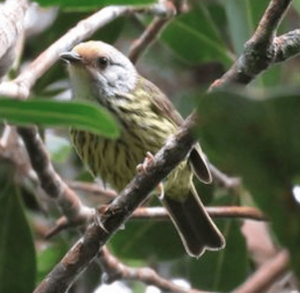Palawan striped babbler facts for kids
Quick facts for kids Palawan striped babbler |
|
|---|---|
 |
|
| Conservation status | |
| Scientific classification | |
| Genus: |
Zosterornis
|
| Species: |
hypogrammicus
|
| Synonyms | |
|
Stachyris hypogrammicus |
|
The Palawan striped babbler (scientific name: Zosterornis hypogrammicus) is a special kind of bird. It belongs to the Zosteropidae family, which includes many small, active birds. This bird is found only in one place: the island of Palawan in the Philippines. It lives in wet, tropical montane forests, which are forests found on mountains. Sadly, its home is shrinking because of habitat loss.
Contents
What Does the Palawan Striped Babbler Look Like?
This bird is quite small. It has dark brown feathers on its back. Its belly is heavily streaked with black lines. The color on its belly changes from white near its throat to a light brown (buffy) color lower down.
You might notice its white face, which has black edges. It also has a thin black stripe right behind its eye. These birds often join groups of different bird species. They look a bit like other birds called Rhabdornises, but the Palawan striped babbler is smaller. It also doesn't have a wide black band across its eye. When it sings, it makes a loud, quick trilling sound. These birds usually look for food close to the ground.
Where Does This Bird Live?
The Palawan striped babbler lives in primary montane mossy forests. These are old, untouched forests found on mountains. They live at high elevations, from about 1,000 meters (3,300 feet) to 2,000 meters (6,600 feet) above sea level.
This bird is only found on three specific mountains in Palawan. These are Mount Mantalingajan, Mount Victoria, and Mount Borangbato.
Why Is This Bird Important?
The Palawan striped babbler is one of four types of "striped babblers." The other three are the Luzon striped babbler, the Panay striped babbler, and the Negros striped babbler. The Palawan striped babbler is the most unique among them. While the others are mostly plain brown, the Palawan striped babbler has special olive-yellow markings.
What About Its Conservation Status?
Even though this bird lives in a very small area, experts have listed it as "least concern." This means it is not currently in immediate danger of disappearing. However, its main threat is habitat loss. Forests where it lives are being cleared. This happens because of logging (cutting down trees), converting land for farming, and mining activities. All these actions reduce the amount of forest available for the birds.


